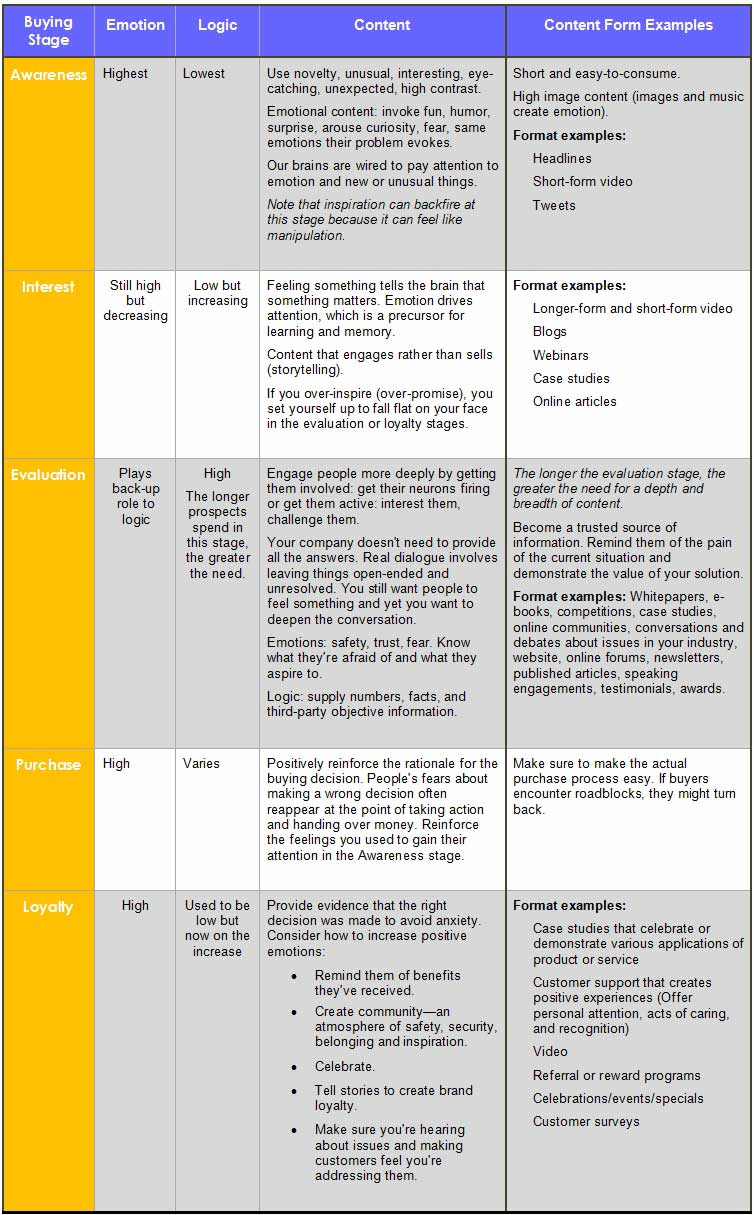Last week, in Part 1, we began to examine how emotion and logic operate in the buying cycle, and we covered what sort of content to produce for the Awareness stage. This week, the remaining four stages of the buying cycle...
Stage 2: Interest
During the Interest stage of your buying cycle, people are beginning to recognize a need for your product or service. They're aware of a problem or opportunity and the potential for a solution.
Now aware of an issue, they're are willing to spend a little more time. Thus, your content can be a little longer.
At this stage, you start building relationships with people. The need for emotional content is still high, but the need for logical content starts to build. You want content that engages rather than sells. In storytelling language, this is where you're starting to build the story of who you are—fleshing out your personality and your values.
That said, simple, inexpensive purchases won't require a lot of logic to back them up. The aforementioned Red Bull marketing is an example. By themselves, each Red Bull gives you wings video functions to get your attention. As a whole, the series of videos functions to reinforce the Interest stage.
However, chances are that if you're selling B2B, you'll need more logic in your materials. We'll discuss the reasons under the Evaluation stage.
Stage 3: Evaluation—Ramping Up the Logic
In the evaluation stage, people are seriously considering your product or service—and comparing you with your competition.
Logic becomes much more significant—particularly for complex sales. There's still an emotional component—people need to feel a sense of safety and trust—but they're looking for logical reasons on which to base those feelings.
At this stage, provide people with good, solid materials that enable people to substantiate their early feelings of security and trust; otherwise, people will feel something is off and they'll look elsewhere for solutions.
Typically, the more complex a buying decision, the more logic plays a role in the purchase decision. You might make an impulse buy in the grocery lineup with little thought, but a company making a substantial purchase tends to take longer and evaluate the effect of the purchase on their business.
In addition, the evaluation stage tends to lengthen as purchases become more complex. Overall, business-to-business purchases tend to be more complex, because...
- People doing the purchasing are experts or have more knowledge than the average buyer.
- Purchase decision-makers are accountable to more people than just themselves: There's pressure to be right and often fear of making a wrong choice.
- Frequently more than one person is involved in the buying decision (which also means your materials have to be able to satisfy a number of different buying personalities).
However, it's not just B2B markets that are becoming more complex. At one time, sellers were the experts on products; they held most, if not all, of the knowledge. With the Internet, that's no longer true. Today's consumer is a lot more savvy, which means that complex purchases are on the rise in the B2C marketplace.
How do you tell a complex purchase? Overall, complex purchase decisions...
- Are more expensive (status purchases are the exception: e.g., high-end cars, fashion, etc. These purchase decisions tend to be highly emotional)
- Tend to be more complicated: e.g., technology purchases
- Involve a higher level of buyer sophistication or knowledge
The takeaway—whether you're selling B2B or B2C—is that the longer your buyers remain in the evaluation stage, the greater logic plays a role and the greater the need for your company to provide a solid depth and breadth of content.
Stage 4: The Purchase
When people are ready to purchase, you need to positively reinforce the rationale for the buying decision. People's fears about making a wrong decision often re-emerge at the point of taking action and handing over money. So, reinforce the feelings that you used to gain their attention in the Awareness stage, and ensure the actual purchase process is painless.
Stage 5: After the Purchase—Loyalty
The last stage of your buying cycle is Loyalty—at least if you're looking to have repeat business. Loyalty is about maintaining a relationship with your customers for the long term.
Obviously, emotion plays a big role in maintaining loyalty. Your company has to maintain that sense of safety and trust that you established in earlier stages. You're creating community, expanding relationships, and awakening inspiration.
However, these days, emotion alone probably isn't going to keep people on your side for the long haul. With the Internet, social media and the number of products competing for people's attention, your company has to provide information that proves it deserves your customer's continued trust.
The other thing is that people are starting to expect companies to commit to a larger vision than just making money—such as standing for certain values, having a greater purpose, and incorporating environmental and social factors into business. They're asking more questions about how products are made and how the company operates, which means that logic is playing a bigger role than ever in maintaining loyalty.
Making It Easy for You: Summary Table
Does this seem like a lot to think about? To make it less daunting, I've summarized the information in a table that you can use when planning your content marketing strategy:
Keep in mind that we're talking in generalities in terms of the purchase cycle. Every company has its own unique buying cycle. These concepts are most powerful when you adapt them to your situation. Closely examine your audience and their needs to choose the best content format for each stage.
In addition, formats are interdependent. The strategy and format you choose at one stage should lead people seamlessly into the strategy and format of the next stage. Basically, you're continually deepening the conversation you're having with people.
Remember also that not every buyer will go through your buying cycle in a linear fashion. For example, buyers who are at the point of actively seeking a solution are already at the evaluation stage—but they might have just found out about your product or service.
Think about whom you're trying to reach and where they are in your purchasing process when producing content.
* * *
Understanding the function and interplay of logic and emotion at the different stages of your cycle empowers you to be able to create the right content to support your buyers at the right time. That provides you a great framework to strategize your content marketing. Instead of persuading people to buy,you provide the materials to nurture curious buyers and enable people to convince themselves.
That's just good content marketing.
Sources:
- Livingston, Sharon, PhD. The Gold at the End of the Ladder. (PDF)
- Sanders, Laura. April 10, 2012. Why Emotions Are Attention-Getters.
- Willis, Judy, PhD. May 9, 2010. Want Children to "Pay Attention"? Make Their Brains Curious!





